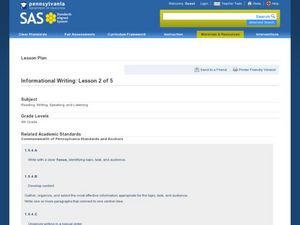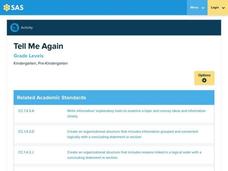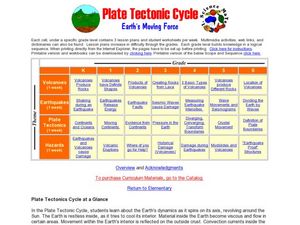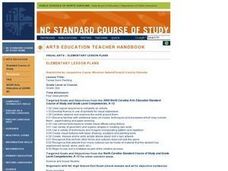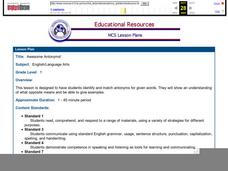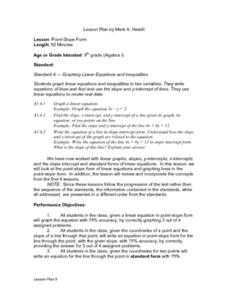Curated OER
Logical Sequence
Students examine logical and illogical sequences in writing. They identify illogical sequences of sentences in a letter. Students retell short stories using a logical sequence and students place sentences in logical order.
Pennsylvania Department of Education
Informational Writing: Lesson 2 of 5
Introduce expository writing to your elementary learners. Young authors write a three-paragraph informational paper using the steps of the writing process. They follow guided lessons to experience each of five steps. Included are tons of...
Curated OER
Zero is Our Hero
Students practice counting sets of items by 10's. In this counting lesson, students create flash cards that show a zero while hiding the first number in order for students to practice counting by 10's. Students practice...
PBS
Patterns to the Rescue!
Track down the Cyberchase episode that this instructional activity is associated with. Using a worksheet that is embedded in the plan, learners must find the next two numbers and shapes (a double pattern). Once these have been...
Pennsylvania Department of Education
Tell Me Again
Students demonstrate how to retell a story in sequential order. In this reading comprehension lesson, students listen to a suggested read aloud, such as Little Boy Blue. Additionally, students practice retelling the story by using...
Curated OER
Understanding and Using Root Words to Expand Vocabulary
Middle schoolers engage in a lesson which reminds them that root words indicate the base meaning of a word, and that those roots are found in many different words that have similar meanings. Pairs of pupils use construction paper and...
Curated OER
Inductive and Deductive Reasoning
Students use logical arguments and inductive reasoning to make or disprove conjectures. After observing a teacher led demonstration, students discover that the deductive process narrows facts to a few possible conclusions. In groups,...
Curated OER
Plate Tectonic Cycle
Students explore the Earth's movements by completing worksheets. In this plate tectonics activity, students define such natural disasters as volcanoes, earthquakes, tsunamis and mudslides and discuss their connections to plate tectonics....
Curated OER
Tansai Sumi Painting
First graders study Japanese art and apply the technique of Tansai Sumi (lightly colored) to create individual works of art. Painting, design, lines, and drawing techniques are covered in this 1st grade instructional activity.
Curated OER
Cooking With Cuisinaires
Second graders explore fraction with Cuisenaire Rods. In this fraction lesson, 2nd graders recieve "recipe" cards for adding fractions. After practicing, students create their own cards then exchange with each other to...
Curated OER
Patriotic Songs
First graders recognize patriotic songs of America. In this historical music lesson, 1st graders discuss the historical background of the song "Yankee Doodle" and repeat the lyrics after the instructor. Students read the lyrics to the...
Curated OER
A Creative Presentation
Young scholars read chapter books by Gary Paulsen. In groups, they identify imagery presented in the book. Students locate 10 quotes, categorize each quote into one of the five senses, and then organize it and create a display of their...
Curated OER
The Dollar Cookie
Second graders recognize, count, and write money amounts using the cent symbol and identify equivalent amounts of money. In this money lesson plan, 2nd graders add money amounts using plastic coins and magnetic money.
Pennsylvania Department of Education
Counting Numbers: Four
Young scholars practice counting to four. In this counting to four lesson, students access an e-book at "I Save A Tree.com" where they count items up to four. They examine the text and images which can be seen in both Spanish and English.
Pennsylvania Department of Education
6 Traits: Voice
Students explore the trait of voice. In this language arts instructional activity, students focus on the writing trait of voice. Students view a video and practice writing.
Pennsylvania Department of Education
6 Traits: Word Choice
Students explore language arts by participating in a vocabulary usage activity. In this word choice lesson, students read examples of great word usage in literature and discuss with the class why some words appear stronger than others....
Pennsylvania Department of Education
Analyzing Key Ideas and Details in Nonfiction
Learners explore nonfiction texts. In this language arts lesson, students read a nonfiction text and make predictions. Learners identify facts and opinions in the text and draw conclusions as they read.
Curated OER
Peer Editing
Sudents read and critique three of their fellow classmates' science fiction short stories on three consecutive days for mechanics, short story elements, style, and informational elements.
Pennsylvania Department of Education
Giving Things a Name
Students label images seen on an interactive website. In this early writing lesson, students do their best to write the name of the object seen on the screen.
Curated OER
Aboriginal Legends
Students listen to and read legends and see that these legends helped the Aboriginals explain their everyday life. Through their stories and legends we find that Aboriginal values, attitudes and cultural identities are shared.
Curated OER
Awesome Antonyms
Review with your young learners what opposites are and use a fun tag board game called Auntie Alice to practice. After the class plays the game, pairs work on computers practicing with interactive matching/flashcards/concentration games...
Curated OER
Nosferatu Expression and Diminished Chords
Students explore how to construct and play diminished triads and half and whole diminished chords on the keyboard. They create appropriate sounds to accompany sections of the movie "Nosferatu: A Symphony of Horrors." Students discuss the...
Curated OER
To Present And Give Controlled Practice of 'could I + Inf' And 'could You + Inf' As Polite Requests
Students practice 'Could I + inf' and 'Could you + inf' as polite requests.
Curated OER
Point-Slope Form
Ninth graders explore the point-slope form of linear equations and graph lines in the point-slope form. After completing the point-slope equation, they identify the slope of a line through a particular point. Students explain the...

